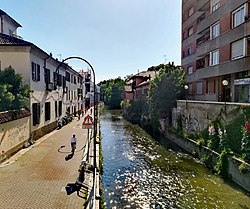Greco | |
|---|---|
Quartiere of Milan | |
 View of the Naviglio della Martesana from Viale Monza towards Greco. | |
 | |
| Coordinates: 45°30′08″N9°12′42″E / 45.502174°N 9.211543°E | |
| Country | |
| Region | Lombardy |
| Province | Milan |
| Comune | Milan |
| Zone | 2 |
| Time zone | UTC+1 (CET) |
| • Summer (DST) | UTC+2 (CEST) |
Greco is a district ( quartiere ) of Milan, Italy, part of the Zone 2 administrative division, located north-east of the city centre. Before being annexed to the city of Milan (in 1923) it was an independent comune, named Greco Milanese. As Greco is the Italian word for 'Greek', it has been suggested that the name refer to an old Greek settlement in the area; nevertheless, scholars tend to believe that the place was actually named after the Greco family that used to live here (at least until the 12th century). [1]
Contents
The architecture and urban layout of Greco still reveal its origins as a small rural borgo . Several old cascine (the typical country house of Lombardy) are still in place and have been restored to meet modern standards while retaining their original overall style.